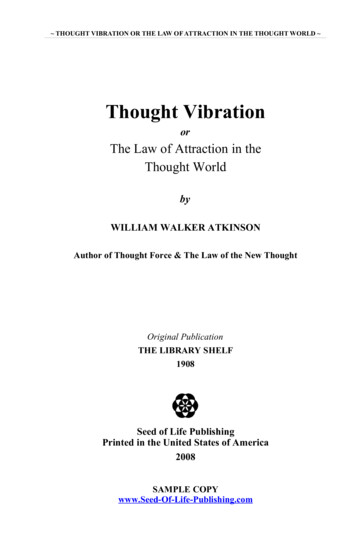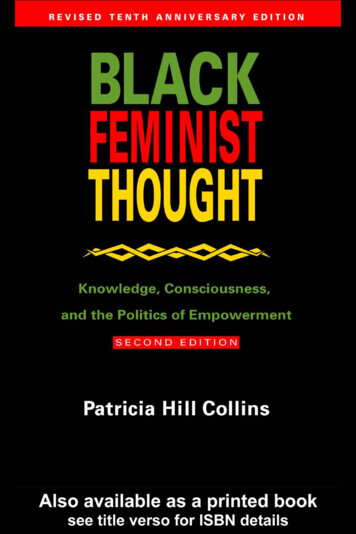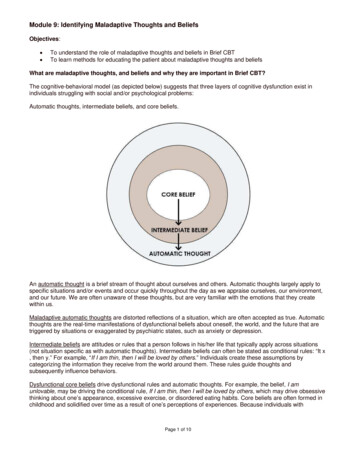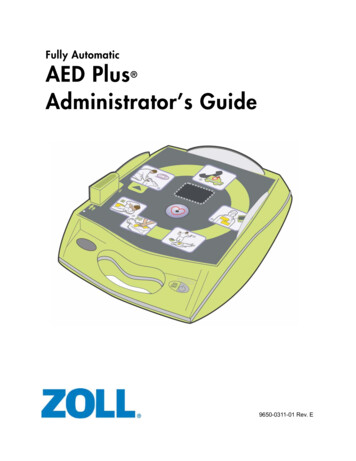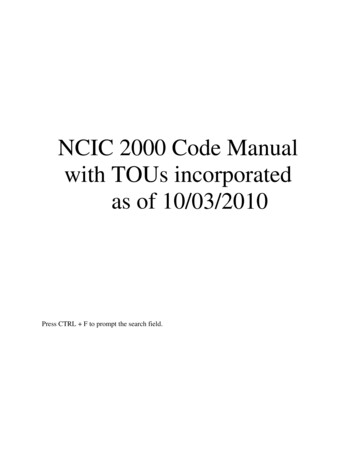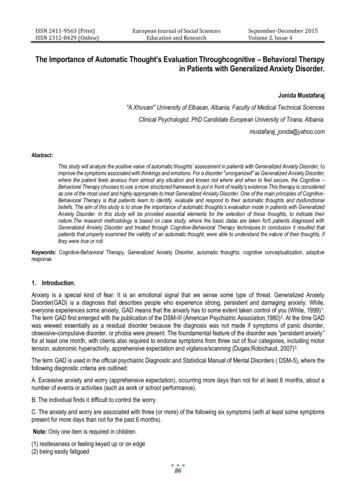
Transcription
ISSN 2411-9563 (Print)ISSN 2312-8429 (Online)European Journal of Social SciencesEducation and ResearchSeptember-December 2015Volume 2, Issue 4The Importance of Automatic Thought’s Evaluation Throughcognitive – Behavioral Therapyin Patients with Generalized Anxiety Disorder.Jonida Mustafaraj"A.Xhuvani" University of Elbasan, Albania, Faculty of Medical Technical SciencesClinical Psychologist, PhD Candidate European University of Tirana, Albania.mustafaraj jonida@yahoo.comAbstract:This study will analyze the positive value of automatic thoughts’ assessment in patients with Generalized Anxiety Disorder, toimprove the symptoms associated with thinkings and emotions. For a disorder "unorganized" as Generalized Anxiety Disorder,where the patient feels anxious from almost any situation and knows not where and when to feel secure, the Cognitive –Behavioral Therapy chooses to use a more structured framework to put in front of reality’s evidence.This therapy is consideredas one of the most used and highly appropriate to treat Generalized Anxiety Disorder. One of the main principles of CognitiveBehavioral Therapy is that patients learn to identify, evaluate and respond to their automatic thoughts and dysfunctionalbeliefs. The aim of this study is to show the importance of automatic thoughts’s evaluation mode in patients with GeneralizedAnxiety Disorder. In this study will be provided essential elements for the selection of these thoughts, to indicate theirnature.The research methodology is based on case study, where the basic datas are taken for5 patients diagnosed withGeneralized Anxiety Disorder and treated through Cognitive-Behavioral Therapy techniques.In conclusion it resulted thatpatients that properly examined the validity of an automatic thought, were able to understand the nature of their thoughts, ifthey were true or not.Keywords: Cognitive-Behavioral Therapy, Generalized Anxiety Disorder, automatic thoughts, cognitive conceptualization, adaptiveresponse.1. Introduction.Anxiety is a special kind of fear. It is an emotional signal that we sense some type of threat. Generalized AnxietyDisorder(GAD) is a diagnosis that describes people who experience strong, persistent and damaging anxiety. While,everyone experiences some anxiety, GAD means that the anxiety has to some extent taken control of you (White, 1999)1.The term GAD first emerged with the publication of the DSM-III (American Psychiatric Association,1980)2. At the time GADwas wiewed essentially as a residual disorder because the diagnosis was not made if symptoms of panic disorder,obsessive-compulsive disorder, or phobia were present. The foundamental feature of the disorder was “persistent anxiety”for at least one month, with clients also required to endorse symptoms from three out of four categories, including motortension, autonomic hyperactivity, apprehensive expectation and vigilance/scanning (Dugas;Robichaud, 2007)3.The term GAD is used in the official psychiatric Diagnostic and Statistical Manual of Mental Disorders ( DSM-5), where thefollowing diagnostic criteria are outlined:A. Excessive anxiety and worry (apprehensive expectation), occurring more days than not for at least 6 months, about anumber of events or activities (such as work or school performance).B. The individual finds it difficult to control the worry.C. The anxiety and worry are associated with three (or more) of the following six symptoms (with at least some symptomspresent for more days than not for the past 6 months).Note: Only one item is required in children.(1) restlessness or feeling keyed up or on edge(2) being easily fatigued86
ISSN 2411-9563 (Print)ISSN 2312-8429 (Online)European Journal of Social SciencesEducation and ResearchSeptember-December 2015Volume 2, Issue 4(3) difficulty concentrating or mind going blank(4) irritability(5) muscle tension(6) sleep disturbance (difficulty falling or staying asleep, or restless unsatisfying sleep)D. The anxiety, worry, or physical symptoms cause clinically significant distress or impairment in social, occupational, orother important areas of functioning.E. The disturbance is not attributable to the physiological effects of a substance (e.g., a drug of abuse, a medication) oranother medical condition (e.g., hyperthyroidism).F. The disturbance is not better explained by another mental disorder (e.g.,anxiety or worry about having panic attacks inpanic disorder, negative evalutation in social anxiety disorder [social phobia], contamination or other obsessions inobsessive compulsive disorder, separation from attachment figures in separation anxiety disorder, reminders of traumaticevents in posttraumatic stress disorder, ganing weight in anorexia nervosa, physical complaints in somatic symptomdisorder, perceived appearance flaws in body dysmorphic disorder, having a serious illness in illness anxiety disorder, orthe content of delusional beliefs in schizophrenia, or delusional disorder) ( DSM-5, 2013).4Cognitive- Behavior Therapy has broad evidence as a powerful intervention for mental health problems in adults. Cognitive– behavior treatments have an empirical base and majority of practitioners,at least in North America, are trained in ascientist-practioner model ( Dobson, 2009).5Automatic thoughts are a stream of thinking that coexists with a more manifest stream of thought (Beck, 2011). 6 Thesethoughts are not peculiar to people with psychological distress; they are an experience common to us all. Most of the timewe are barely aware of these thoughts, although with just a little training we can easily bring these thoughts intoconsciousness. When we become aware of our thoughts, we may automatically do a reality check if we are not sufferingfrom psychological dysfunction ( Beck, 2011).7It is very important distinguishing automatic thoughts from emotions. Many patients do not clearly understand the differencebetween their thoughts and their emotions. Emotions are of primary importance in cognitive- behavior therapy. People withpsychological disorders, however, often misconstrue neutral or even positive situations and thus their automatic thoughtsare biased. By critically examining their thoughts and correcting thinking errors, they often feel better (Beck, 2011). 82.Understanding anxiety and thinking in GAD.Anxiety is a prolonged complex emotional state that is often triggered by an initial fear. Fear is at the heart of all anxietystates. Fear is the underlying psychological state that drives the anxiety (Clark&Beck, 2012). 9To understand the anxiety it is important to know some of the common effects of anxiety:Psychical symptoms Increased heart rate, palpitationsShortness of breath, rapid breathingChest pain or pressureChoking sensationDizziness, lightheadednessSweating, hot flashes, chillsNausea, upset stomach, diarrheaTrembling, shakingTingling or numbness in arms, legsWeakness, unsteadiness, faintnessTense muscles, rigidityDry mouth87
ISSN 2411-9563 (Print)ISSN 2312-8429 (Online)European Journal of Social SciencesEducation and ResearchSeptember-December 2015Volume 2, Issue 4Cognitive symptoms Fear of losing control, being unable to copeFear of physical injury or deathFear of “going crazy”Fear of negative evaluation by othersFrightening thoughts, images, or memoriesPerceptions of unreality or detachmentPoor concentration, confusion, distractibilityNarrowing of attention, hypervigilance for threatPoor memoryDifficulty in reasoning, loss of objectivity Behavioral symptoms Avoidance of threat cues or situationsEscape, flightPursuit of safety, reassuranceRestlessness, agitation, pacingHyperventilationDifficulty speakingEmotional symptoms Feeling nervous, tense, wound upFeeling frightened, fearful, terrifiedBeing edgy, jumpy, jitteryBeing impatient, frustrated, ( Clark&Beck, 2012).10The common thinking errors in interpretation are : Catastrophizing, faulty estimates, gross generalizations, polarization,minimization. Catastrophizing is evident when the individual’s thoughts focus exclusively on the worst possible outcomesof events. Faulty estimates are evident when the probability of danger is assessed at inaccurately high levels, particularlywhen the actual probability of danger is ambiguous. Gross generalizations are evident when the danger perceived in oneevent is applied to other events, without any differentiation between events. polarization is evident when are perceived inall-or-nothing terms of extreme danger or safety. Factors that indicate protection or safety may be minimized or ignored(Rygh&Sanderson, 2004). 11The cognitive component of GAD can be modulated with a wide variety of techniques. These techniques includepsychoeducation, cognitive restructuring, hypothesis testing, positive imagery, worry exposure, improving problemorientation, cost-benefit analysis of coping and two cognitive response prevention techniques:scheduled worry time andworry-free zones. The cognitive components of GAD are: psychoeducation, cognitive restructuring, worry episode log,guided discovery, decatastrophizing, developing alternative viewpoints, hypothesis testing, positive imagery, worryexposure, improving problem orientation, cost-benefit analysis of coping, cognitive response prevention, scheduled worrytime and worry-free zones (Rygh&Sanderson, 2004).12People with GAD haveinconsistent thoughts and can not control them. Therefore, it is important to apply strategies tocontrol thisthoughts. Most of the time, strategies used to control the thoughts from individuals themselves are not effective.There is a little available research on the nature of thoughts control strategies used by individuals with GAD. However,evidence from other sources suggests that some such strategies may be ineffective and perhaps countproductive.Research with thought control Questionnaire suggests that worry and punishment, when conceptualized as thought controlstrategies, are associated with emotional disturbances (Heimberg&Turk&Mennin, 2004). 13The treatment of thinking through Cognitive-Behaviour Therapy (CBT), theoretical and practical models.88
ISSN 2411-9563 (Print)ISSN 2312-8429 (Online)European Journal of Social SciencesEducation and ResearchSeptember-December 2015Volume 2, Issue 4The majority of people experiencing GAD do not seek treatment. They tend to regard themselves as chronic worriers andassume that nothing can really help them. Untreated, GAD tends to last longer and impact a greater portion of a person’slife. The traditional treatment stems from Freud’s work and maintains that the cause of anxiety is usually rooted in childhood.It is belived that by returning to these earlier issues the client’s fundamental conflict can be brought to the surface andresolved. The cognitive part of CBT refers to the power of our beliefs. What we believe about ourselves, our world and ourfuture has a strong influence on what actually happens. The behavior part of CBTacknowledges that real change happensin our life only when when we do things differently. There needs to be some kind of action that brings the new direction tolife (White, 1999). 14One important step of CBT is to identificate the negative thoughts.The clients most become aware of their thoughts, the actof metacognition. Some clients are quite “psychologically minded”and understand these ideas fairly quickly, whereas othersstruggle with some of these notions and exercises. Some clients may object to terms such as dysfunctional or distortedthoughts. The onus is on the therapist to find substitutions that have the same meaning but are more palatable to clients.for example, we may use the phrase” thoughts that make us feel bad” or “thoughts that lead to negative emotions(Dobson,2009). 15Thera are many techniques to change the anxiety thinking. From anxious thinking to normalized thinking we must use skillsto understand the anxious mind. There are some diagrams to illustrate this shift in thinking (Clark&Beck, 2012). 16Exercise for thought monitoring (Clark&beck, 2012).17A two-step process for learning to catch core anxious thoughts:12-Monitoring the anxious thoughtsThreat assessment diary.89
ISSN 2411-9563 (Print)ISSN 2312-8429 (Online)European Journal of Social SciencesEducation and ResearchSeptember-December 2015Volume 2, Issue 4Anxiety work planTargeted anxiety symptomsInterventions exercisesSelf-help scheduleOutcomePART I. ANXIETY TRIGGERS (situations, etc.)1.2.3.From the Anxiety and worry workbook, Clark&Beck, 2012). 183. The importance of evaluating Automatic Thoughts (AT).Our thoughts are created by our mind, which is constantly helping us to interpret the world around us, describing what’shappening, and trying to make sense of it by helping us interpret events, sights, sounds, smells, feelings. Automaticthoughts can be words, an image, a memory, a physical sensation, an imagined sound, or based on ‘intuition’ – a sense ofjust ‘knowing’(Vivyan, 2009).19Automatic thoughts seem to pop up spontaneously, they become fairly predictable once the patient’s underlying beliefs areidentified. Automatic thoughts are usually quite brief and patient are often more aware of the emotion they feel as a resultof their thoughts than of the thoughts themselves. Automatic thoughts are often in “shorthand” form, but can be easilyspelled out when the patient ask for the meaning of the thought. These can be evaluated according to their validity andtheir utility. To summarize, automatic thoughts coexist with a more manifest stream of thoughts, arise spontaneously andare not based on reflection or deliberation. People are usually more aware of the associated emotion, but with a littletraining, they can become aware of their thinking (Beck, 2011). 20To evaluate appropriately the automatic thoughts, the clinician first must learn the patient to identify them. There are someimportant steps to identify automatic thoughts and than to evaluate them.Eliciting AT – how to identify steps:1.2.3.4.5.6.7.8.Heightening the Emotional and Physiological response.Eliciting a detailed descriptionVisualizing the situation.Re- creating an interpersonal situation through role play.Eliciting an image.Suggesting an opposite thought.Uncovering the meaning of the situation.Phrasing the question differently (Beck, 2011).21To conduct a correct automatic thought’s evaluation, the clinician must know to identify additional AT, the problematicsituation and to regognize the situations that can evoke AT. This could be able with the client’s help.4. Method.The basic datas are taken for5 patients diagnosed with Generalized Anxiety Disorder and treated through CognitiveBehavioral Therapy techniques.Table 1. Patients characteristics.90
ISSN 2411-9563 (Print)ISSN 2312-8429 (Online)European Journal of Social SciencesEducation and ResearchSeptember-December 2015Volume 2, Issue 4All Patients (n 5)Treatment with CBT (n 5)Practice for AT evaluating (n 4)Number femaleSelf anxiety measuredStabilized on medication at start of treatment432331331AgeAdditional diagnose except GADMood disorders402402402Measures.The Anxiety and Related Disorders Interview Schedule for DSM-5 (ADIS-5) - Adult and Lifetime Version (Timothy A.Brown and David H. Barlow,2014),was used to determine current and lifetime DSM-5 diagnostic status (an abbreviatedversion focusing on current diagnoses was given for post- and follow-up assessments). The ARDIS-5 includes a clinicalseverity rating (CSR) for each diagnosis. All assessments were administered by clinic psychologists in their clinic practice.To the five patient was applied the Self-Evaluation Questionnaire, STAI form Y-1 and Self-Evaluation Questionnaire, STAIform Y-2 (White1999).22With all the patient were used the techniques for AT evaluation. The questioning to help patients evaluate their thinking: Examine the validity of AT.Explore the possibility of other interpretations or viewpoints.Decatastrophize the problematic situation.Regognize the impact of believing the AT.Gain distance from the thought.Take steps to solve the problem.The AT are collected by the patients in spontaneous way during the sessions. The important AT distinguished because arein a strong relation with the initial patient’s complaint. Very important is to distinguish the true facts. The clinician has tokeep in mind that AT are rarely completely erroneous. Usually they content a grain of truth (Beck, 2011). 23Example for one case, to see the way how the AT effect all the cognitive construct of the person.Case 1, female, 38 years old.AT identified – “My husband is not interested for my career”.1.2.3.4.5.6.7.8.9.10.11.What is the evidence tha supports this idea?“ He don’t ask me what I do every day in my job.”Is there an alternative explanation or viewpoint?“ I don’t think so.” – negativeWhat is the worst that could happen?“If my husband will not be worried if I let the job.”What is the effect of my believing the AT?“I feel anxious and pessimist.”What would I tell to a specific person?“ I will tell to my husband that I don’t care about him.”What should I do?“ I have to tell him that my career is very important for me.”After has been seen how the AT effect the patient thinking and believing, the clinician must understand the differencebetween true or untrue AT. For this aim it can be used the version of A.T.Beck, for tipical mistakes in thinking:91
ISSN 2411-9563 (Print)ISSN 2312-8429 18.19.20.21.22.23.European Journal of Social SciencesEducation and ResearchSeptember-December 2015Volume 2, Issue 4All-or-nothing (also called black and white, polarized or dichotomous thinking).Examplecase 1: “ If my husband doesn’t ask about my job, he doesn’t love me.”Catastrophizing (also called fortune-telling)Example case 1: “ I will be so upset, I won’t talk to my husband all day.”Disqualifying or discounting the positive.Example case 1. “ My husband call me many times a day, but he never ask me if I have any problem at job.”Emotional reasoning.Example case 1: “ I have a good relationship with my husband, but I still feel that I’m not very important for him.”Labeling.Example case 1: “I’m upset, he is disgraceful.”Magnification/minimization.Example case 1: “ When he doesn’t ask me about my career, makes me feel very worthless. Having goodrelationship with him, doesn’t mean he’s interested in me.”Mental filter (also called selective abstraction).Example case 1: “Because he doesn’t make me many questions about my job, it means he doesn’t love me.”Mind reading.Example case 1: “ He think I’m not capable in my job.”Overgeneralization.Example case 1: “These dissadisfaction can make unfavorable our relationship.”Personalization.Example case 1: “ He doesn’t care about my career because I did something wrong.”“Should and Must” statements (also called imperatives).Example case 1: “It’s terrible for me if I don’t have my husband’s attention all the time.”Tunnel vision.Example case 1: “ My husband doesn’t like my professionality.”To registrate the AT is used the Thought record ( White, 1999):23Triggering situationAnxiety and other feelingsAutomatic thoughtsWorst outcomeRerate feelings and thoughtsThe uncertainty is one important causefor the appearance of AT. Acceptance of uncertainty can be addressed by workingto do the following (Wiiliam&Knaus, 2008):251.2.3.4.Accept facts and reality.Accept that you can progressively master methods for overcoming uncertainty fears.Accept that a prime solution involves for uncertainty may prove uncomfortable but is instrumental to positivechange.Accept that overpreparation, such as repeatedly going over every possible scenario, supports a misguided viewthat perfection is the solution for controlling tension.5. Results.After this process the patient were able to evaluate their AT. Not all of them were able initially to identify them, but after aguided help they could evaluate appropriately their AT. Evaluating the At was helpful for the identifying of emotions too.This wsa helpful too for the patient’s interaction when they play themselves through role play. After identifying andevaluating AT, additional questioning brings to light other important thoughts. The patients, in addition, have other automaticthoughts not about the same situation itself, but about their reaction about that situation. They may perceive their emotion,behavior, or physiological reaction in a negative way.92
ISSN 2411-9563 (Print)ISSN 2312-8429 (Online)European Journal of Social SciencesEducation and ResearchSeptember-December 2015Volume 2, Issue 4Amoung this process it had been seen that the AT could appear before a situation, in anticipation of what might happen,during a situation and/or after a situation, reflecting on what had happened. In addition to being unable to identify automaticthoughts associated with a given emotion, patients have difficulty even identifying a particular situation or issue that is mosttroublesome to them. Many patient amoung this process reported interpretations, which may or may not reflect their actualthoughts. The best way in this cases is to guide the patients to report their thoughts. Patients often report thoughts that arenot fully spelled out. It was difficult to evaluate a telegraphic thought, so the best way was to guide the patients to expressthe thoughts more fully. The patients had thoughts about their cognitions, their emotions, their behavior or their physiologicalor mental experiences. Any of these stimuli engendered initial AT followed by an initial emotional, behavioral, orphysiological reaction.To summarize, the patients was learned to identify their dysfunctional thinking, then to evaluate and modify it. The processstarted with the recognition of specific AT in specific situations and than evaluate the AT and situation itself.References.[1]White (1999) Overcoming Generalized Anxiety Disorder. pp.3[2]APA (1980) DSM-III.[3]Dugas;Robichaud(2007) Cognitive – Behavioral treatment for Generalized Anxiety Disorder. pp. 3[4]APA (2013) DSM-5. pp. 222.[5]Dobson (2009) Evidence – based practice of Cognitive- Behavioral Therapy. pp.1.[6]Beck (2011) Cognitive Behavioral Therapy basics and beyond. Pp.137.[7]Beck (2011) Cognitive Behavioral Therapy basics and beyond. Pp.138[8]Beck (2011) Cognitive Behavioral Therapy basics and beyond. Pp.158.[9]Clark&Beck (2012) The anxiety and worry workbook, the Cognitive Behavioral solution.pp.15.[10] Clark&Beck (2012) The anxiety and worry workbook, the Cognitive Behavioral solution.pp.16-18.[11] Rygh&Sanderson (2004) Treating Generalized Anxiey Disorder, Evidence-Based strategies, tools andtechniques.pp.83-84.[12] Rygh&Sanderson (2004) Treating Generalized Anxiey Disorder, Evidence-Based strategies, tools andtechniques.pp.22.[13] Heimberg&Turk&Mennin (2004) Generalized Anxiety Disorder advances in research and practice.pp.177.[14] White (1999) Overcoming Generalized Anxiety Disorder. pp.3[15] Dobson (2009) Evidence – based practice of Cognitive- Behavioral Therapy. pp.117.[16] Clark&Beck (2012) The anxiety and worry workbook, the Cognitive Behavioral solution.pp.98.[17] Clark&Beck (2012) The anxiety and worry workbook, the Cognitive Behavioral solution.pp.106.[18] Clark&Beck (2012) The anxiety and worry workbook, the Cognitive Behavioral solution.pp.152.[19] Vivyan (2009) www.getselfhelp.com, date consulted 04.06.15[20] Beck (2011) Cognitive Behavioral Therapy basics and beyond. Pp.137.[21] Beck (2011) Cognitive Behavioral Therapy basics and beyond. Pp.142-146.[22] White (1999) Overcoming Generalized Anxiety Disorder. pp.119.[23] Beck (2011) Cognitive Behavioral Therapy basics and beyond. Pp.170.[24] White (1999) Overcoming Generalized Anxiety Disorder. pp.40.[25] Knaus (2008) The cognitive Behavioral workbook for Anxiety.pp139.93
Keywords: Cognitive-Behavioral Therapy, Generalized Anxiety Disorder, automatic thoughts, cognitive conceptualization, adaptive response. 1. Introduction. Anxiety is a special kind of fear. It is an emotional signal that we sense some type of threat. Generalized Anxiety




